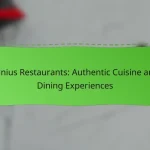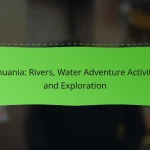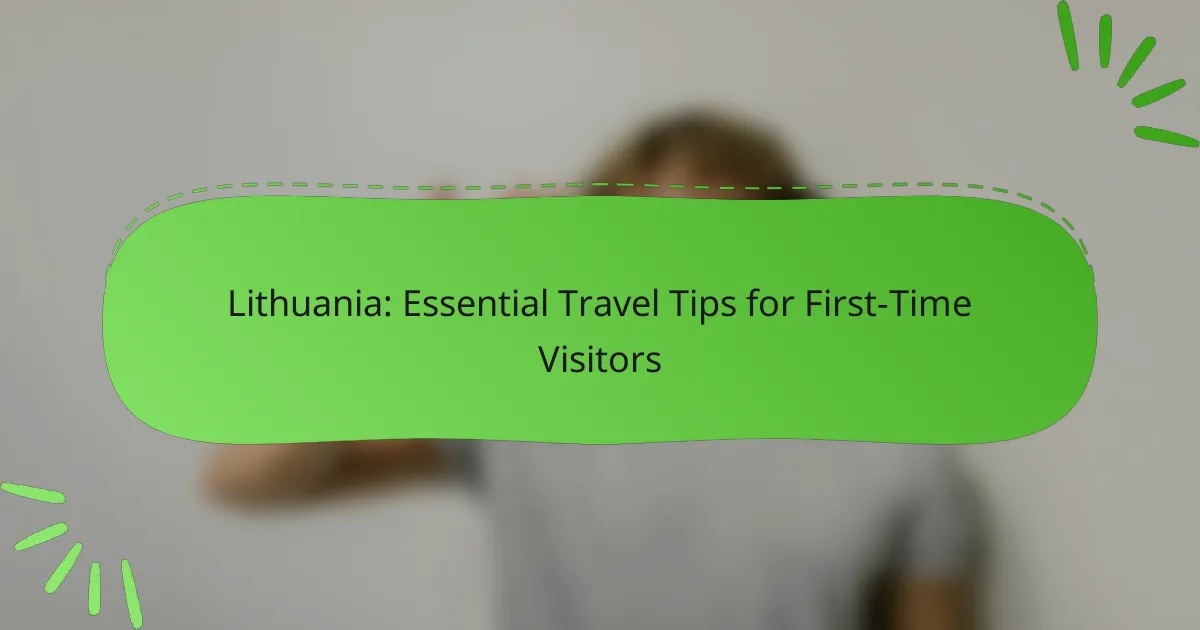Lithuania is a captivating destination for first-time visitors, boasting a rich tapestry of history, culture, and stunning landscapes. To make the most of your trip, it’s essential to prepare by packing wisely, picking up a few local phrases, and familiarizing yourself with cultural customs. With convenient transportation options available, exploring highlights like Vilnius, Trakai Castle, and the Curonian Spit will be both enjoyable and accessible.
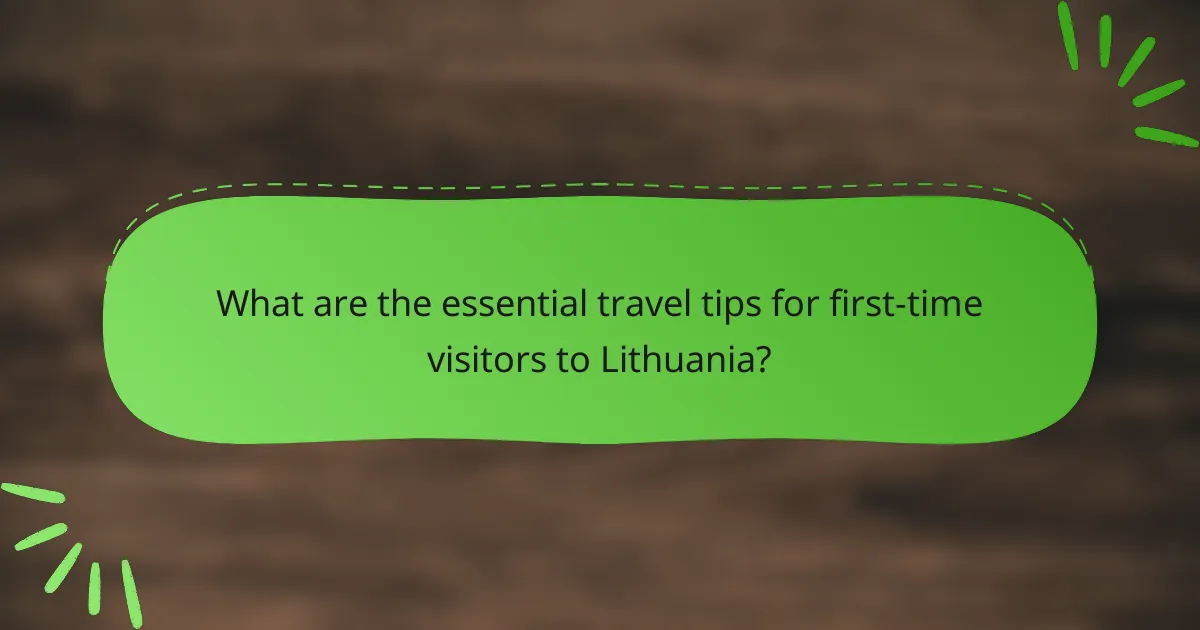
What are the essential travel tips for first-time visitors to Lithuania?
First-time visitors to Lithuania should focus on practical preparations, including packing appropriately, learning some local language, and understanding cultural norms. These tips will enhance your experience and help you navigate the country more smoothly.
Pack for variable weather
Lithuania experiences a range of weather conditions throughout the year, so it’s essential to pack accordingly. Summers can be warm, with temperatures reaching the low 30s °C, while winters are cold, often dropping below freezing.
Layering is key; include a mix of light clothing for warmer days and warmer layers for cooler evenings or unexpected weather changes. Don’t forget a waterproof jacket, as rain can occur at any time, especially in spring and autumn.
Learn basic Lithuanian phrases
Knowing a few basic Lithuanian phrases can significantly improve your interactions with locals. Simple greetings like “Labas” (Hello) and “Ačiū” (Thank you) are appreciated and can help break the ice.
While many Lithuanians speak English, especially in urban areas, using the local language shows respect and can lead to more enriching experiences. Consider downloading a language app or carrying a phrasebook for quick references.
Understand local customs and etiquette
Familiarizing yourself with Lithuanian customs can enhance your visit. For instance, it is customary to greet people with a firm handshake and maintain eye contact. When invited to someone’s home, bringing a small gift, such as flowers or sweets, is a thoughtful gesture.
Dining etiquette is also important; wait for the host to start the meal and avoid discussing sensitive topics like politics. Tipping around 10% in restaurants is standard, so be prepared to add this to your bill.
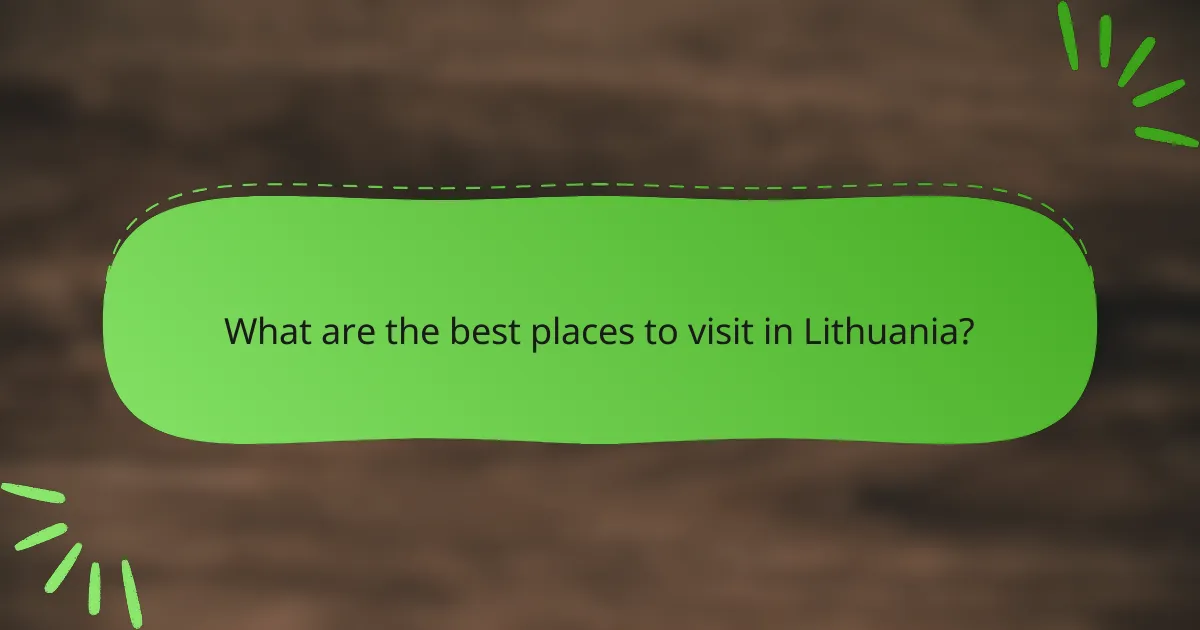
What are the best places to visit in Lithuania?
Lithuania offers a rich blend of history, culture, and natural beauty, making it an exciting destination for first-time visitors. Key highlights include the capital city of Vilnius, the stunning Trakai Castle, and the picturesque Klaipėda along with the Curonian Spit.
Vilnius Old Town
Vilnius Old Town is a UNESCO World Heritage Site known for its well-preserved medieval architecture and vibrant atmosphere. Visitors can explore narrow cobblestone streets, historic churches, and charming squares, with highlights including the stunning Gediminas Tower and the impressive Vilnius Cathedral.
When visiting, consider taking a walking tour to fully appreciate the rich history and cultural significance of the area. Don’t miss the chance to enjoy local cuisine at one of the many cafes and restaurants scattered throughout the Old Town.
Trakai Castle
Trakai Castle, located on an island in Lake Galvė, is one of Lithuania’s most iconic landmarks. This picturesque castle dates back to the 14th century and offers visitors a glimpse into the country’s medieval past. The surrounding lakes and forests create a stunning backdrop for photography and outdoor activities.
To reach Trakai, consider a day trip from Vilnius, which is about 30 kilometers away. While there, try traditional Karaim dishes, such as kibinai, which are delicious pastries filled with meat or vegetables.
Klaipėda and the Curonian Spit
Klaipėda is Lithuania’s only port city, known for its unique blend of German and Lithuanian cultures. The city features a charming old town with colorful buildings and a lively waterfront, making it a great place to explore local shops and enjoy fresh seafood.
The nearby Curonian Spit, a UNESCO World Heritage Site, is famous for its stunning sand dunes and diverse ecosystems. Visitors can enjoy hiking, biking, and birdwatching, with opportunities to see rare species. Plan to spend a day or two exploring this natural wonder, and consider taking a ferry to cross the lagoon for a different perspective.
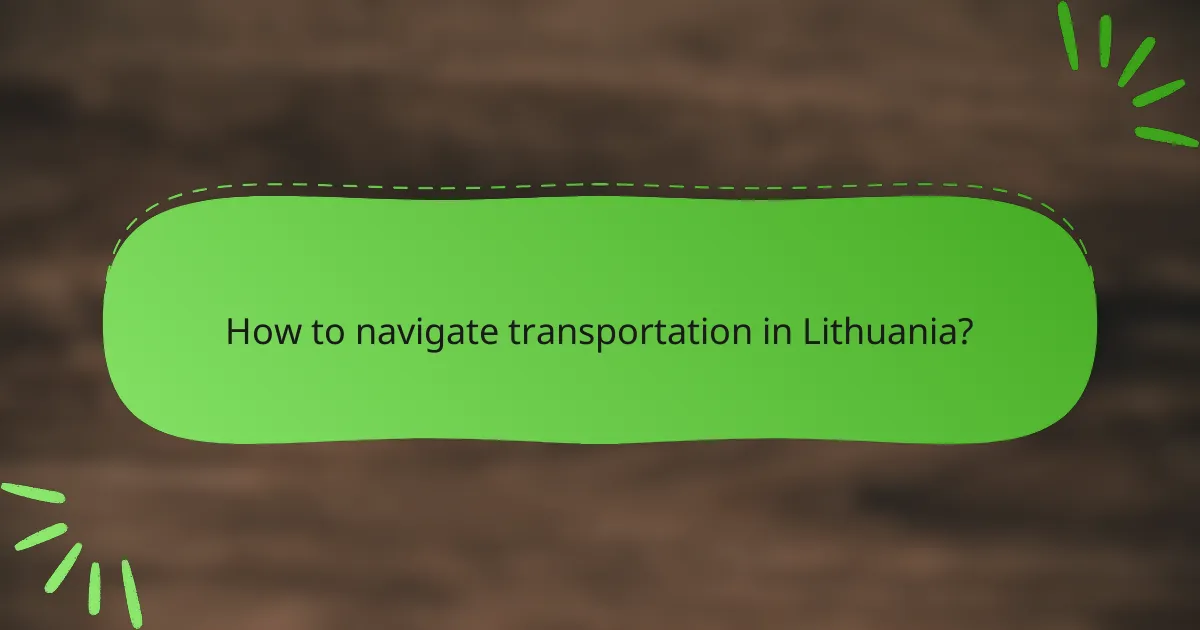
How to navigate transportation in Lithuania?
Navigating transportation in Lithuania is straightforward, with various options available for getting around. Public transportation, car rentals, and taxis or rideshare services cater to different preferences and budgets.
Public transportation options
Lithuania offers a reliable public transportation system, including buses and trams, particularly in cities like Vilnius and Kaunas. Tickets can be purchased at kiosks or via mobile apps, with prices typically ranging from 1 to 2 EUR for single rides.
For longer distances, intercity buses connect major towns and cities, providing an economical travel option. It’s advisable to check schedules in advance, as frequencies may vary, especially on weekends.
Car rental services
Renting a car in Lithuania is a popular choice for those wanting to explore rural areas or travel at their own pace. Major international and local car rental companies operate in airports and city centers, with prices generally starting around 30 EUR per day.
Keep in mind that a valid driver’s license and a credit card are typically required. Familiarize yourself with local driving regulations, such as speed limits and parking rules, to ensure a smooth experience.
Taxi and rideshare availability
Taxis are widely available in urban areas, with fares starting at around 1 EUR plus a per-kilometer charge. It’s best to use reputable taxi companies or apps to avoid overcharging.
Rideshare services like Bolt and Uber are also operational in Lithuania, offering a convenient alternative to traditional taxis. These services usually provide transparent pricing and can be booked easily via their respective apps.

What is the local cuisine in Lithuania?
Lithuanian cuisine is hearty and flavorful, reflecting the country’s agricultural roots and diverse history. It features a variety of ingredients, including potatoes, rye, beets, and dairy, often prepared in traditional ways that highlight their natural flavors.
Traditional dishes to try
When visiting Lithuania, be sure to sample traditional dishes such as cepelinai, which are potato dumplings typically filled with meat and served with sour cream. Another must-try is šaltibarščiai, a cold beet soup that is refreshing and vibrant, especially during the summer months.
Other notable dishes include kugelis, a baked potato pudding, and various types of rye bread, which is a staple in Lithuanian meals. Each dish offers a unique taste of the country’s culinary heritage.
Popular restaurants in Vilnius
Vilnius boasts a range of restaurants where you can enjoy authentic Lithuanian cuisine. One popular spot is Lokys, known for its rustic atmosphere and traditional dishes made from locally sourced ingredients. Another favorite is Senoji Trobelė, which offers a cozy setting and a menu filled with classic Lithuanian fare.
For a more modern twist on traditional dishes, try Sweet Root, where the chef emphasizes seasonal ingredients and innovative presentations. These restaurants provide a great opportunity to experience the local flavors in the heart of the capital.
Food festivals and markets
Food festivals and markets are excellent ways to immerse yourself in Lithuanian cuisine. The Vilnius Street Food Festival, held annually, showcases a variety of local vendors offering everything from traditional dishes to contemporary culinary creations.
Additionally, the Hales Market in Vilnius is a vibrant place to explore local produce, meats, and cheeses. Visiting these events allows you to taste a wide range of Lithuanian foods and interact with local chefs and artisans.
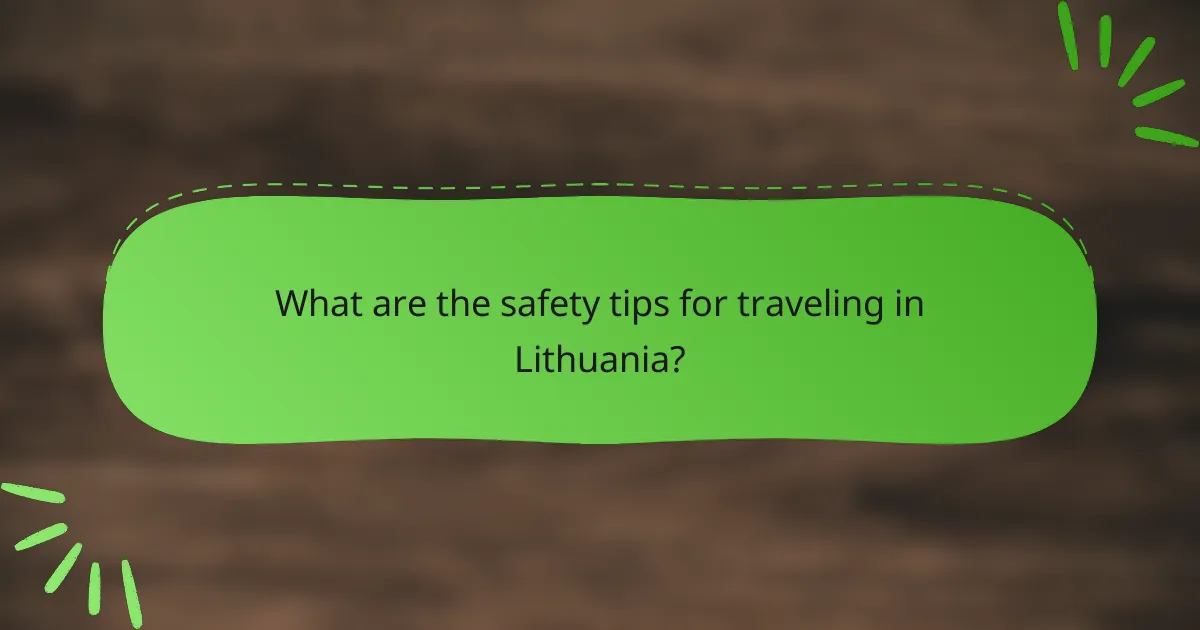
What are the safety tips for traveling in Lithuania?
Traveling in Lithuania is generally safe, but being aware of local customs and potential risks can enhance your experience. Familiarize yourself with common safety tips to navigate the country confidently.
General safety precautions
When visiting Lithuania, stay vigilant in crowded areas and be cautious with your belongings to avoid petty theft. It’s advisable to use reputable transportation services and avoid walking alone at night in less populated areas.
Keep your personal documents secure, and consider carrying a photocopy of your passport. Additionally, be respectful of local laws and customs to ensure a smooth visit.
Emergency contact numbers
In Lithuania, the general emergency number is 112, which you can call for police, fire, or medical emergencies. It’s helpful to memorize this number or keep it accessible during your travels.
For non-emergency situations, you can contact local police at 02 or reach out to your country’s embassy for assistance. Familiarizing yourself with these numbers can save time in critical situations.
Health care facilities
Healthcare in Lithuania is of a good standard, with both public and private facilities available. Major cities like Vilnius and Kaunas have well-equipped hospitals, while rural areas may have limited options.
Travelers should consider obtaining travel insurance that covers medical expenses. In case of illness or injury, seek medical attention promptly, and keep emergency contact numbers handy for assistance.
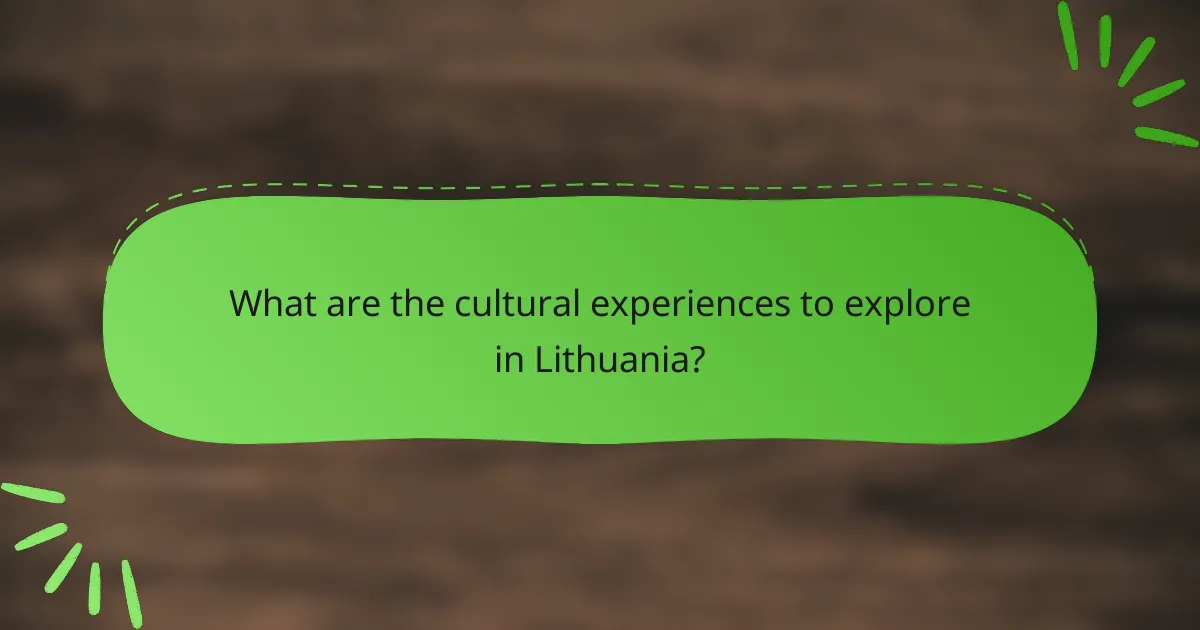
What are the cultural experiences to explore in Lithuania?
Lithuania offers a rich tapestry of cultural experiences that reflect its history and traditions. Visitors can immerse themselves in local customs, art, and cuisine, making their trip memorable and engaging.
Traditional Festivals
Experiencing traditional festivals in Lithuania is a must for first-time visitors. Events like Užgavėnės, celebrated before Lent, feature vibrant masks, folk music, and hearty foods. The Jūratė and Kastytis Festival in Palanga celebrates the sea with music, dance, and maritime-themed activities.
These festivals often include local crafts, showcasing the skills of artisans. Attending a festival can provide insight into Lithuanian culture and community spirit, making it a unique experience.
Local Cuisine
Lithuanian cuisine is hearty and flavorful, with dishes that reflect the country’s agricultural heritage. Must-try foods include cepelinai (potato dumplings filled with meat), šaltibarščiai (cold beet soup), and various rye bread specialties. Many restaurants serve these traditional dishes, often accompanied by local beers or kvass.
Exploring local markets can also enhance your culinary experience. Vendors often sell fresh produce, cheeses, and baked goods, allowing visitors to taste authentic flavors and interact with locals.
Art and Architecture
Lithuania’s art and architecture showcase a blend of influences from various periods. Vilnius, the capital, is known for its well-preserved Baroque architecture, particularly in the Old Town, a UNESCO World Heritage site. Visitors can explore numerous galleries and museums that highlight both contemporary and traditional Lithuanian art.
Don’t miss the chance to see the works of local artists in smaller galleries or street art in urban areas. This diversity in art and architecture reflects the country’s rich history and vibrant modern culture.
Historical Sites
Exploring historical sites is essential for understanding Lithuania’s past. Key locations include the Gediminas Tower in Vilnius, the medieval Trakai Castle, and the poignant Museum of Genocide Victims. Each site offers a glimpse into Lithuania’s journey through various historical epochs.
When visiting these sites, consider guided tours for deeper insights. Many historical locations also provide educational resources to enhance your understanding of their significance.

